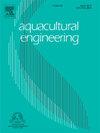IF 3.6
2区 农林科学
Q2 AGRICULTURAL ENGINEERING
引用次数: 0
摘要
过去几十年来,笼养三文鱼养殖业取得了长足发展,但目前在很大程度上仍依赖于经验型生产机制。水产养殖业数字化转型的进展将提高监测、控制和记录生产系统的能力,并促进基于知识的决策。本文提出并测试了一种仪器和解释相结合的解决方案,用于监测水产养殖网箱中鱼类的分布情况。通过基于个体的鱼类模型模拟了全尺寸海网箱中的养殖鲑鱼。通过数据驱动的参数识别,引入并确定实时行为变化,从而反映出一组单波束回声测深仪观测到的鱼群分布情况。这形成了一种混合方法,将基于物理模型的可解释性与先进深度学习算法的自动模式识别能力结合起来。通过与测量到的鱼类密度数据进行比较,对暂定仪器和模型设置的性能进行了评估,同时提供了更多详细信息,如鱼类的数量和游动速度,而使用传统解决方案很难量化这些信息。拟议的混合方法被认为适用于开发更全面的鱼类监测系统,供海水养殖业日常使用。本文章由计算机程序翻译,如有差异,请以英文原文为准。
A hybrid approach towards real-time monitoring of fish distributions in aquaculture net cage
Cage based salmon aquaculture has grown substantially over the last decades, however it is still, to a large degree, relying on experience-based production regime today. Advances in the digital transformation of the aquaculture industry will improve the ability to monitor, control and document the production systems, and facilitate knowledge-based decision making. In this paper, a combined instrumentation and interpreting solution is proposed and tested for monitoring fish distributions in aquaculture net cage. Farmed salmon in a full-scale sea cage are simulated by an individual-based fish model. And real-time behavioural changes are introduced and determined by data-driven parameter identification, thereby reflecting observed fish distributions from a set of single-beam echosounders. This forms a hybrid approach to combine the interpretability of physics-based models with the automatic pattern-identification capabilities of advanced deep learning algorithms. The performance of a tentative instrumental and model setup is evaluated by comparing with measured fish density data, while providing more detailed information such as the number and swimming speed of the fish, which are notoriously difficult to quantify using conventional solutions. The proposed hybrid approach is considered to be suitable for developing a more comprehensive fish monitoring system to be used on a daily basis in marine aquaculture.
求助全文
通过发布文献求助,成功后即可免费获取论文全文。
去求助
来源期刊

Aquacultural Engineering
农林科学-农业工程
CiteScore
8.60
自引率
10.00%
发文量
63
审稿时长
>24 weeks
期刊介绍:
Aquacultural Engineering is concerned with the design and development of effective aquacultural systems for marine and freshwater facilities. The journal aims to apply the knowledge gained from basic research which potentially can be translated into commercial operations.
Problems of scale-up and application of research data involve many parameters, both physical and biological, making it difficult to anticipate the interaction between the unit processes and the cultured animals. Aquacultural Engineering aims to develop this bioengineering interface for aquaculture and welcomes contributions in the following areas:
– Engineering and design of aquaculture facilities
– Engineering-based research studies
– Construction experience and techniques
– In-service experience, commissioning, operation
– Materials selection and their uses
– Quantification of biological data and constraints
 求助内容:
求助内容: 应助结果提醒方式:
应助结果提醒方式:


